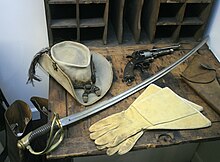James Ewell Brown Stuart
James Ewell Brown "JEB" Stuart (born February 6, 1833 "Laurel Hill" in Patrick County , Virginia ; † May 12, 1864 in Richmond , Virginia) was an officer in the US Army until 1861 and then general of the Confederate Army in the American Civil War .
Life
Stuart, the son of a relatively wealthy and politically active family from southern Virginia , attended the military academy in West Point , New York , which he graduated in 1854 when he was thirteenth of his class. His career in the US Army led him directly to the cavalry . As an officer in the Mounted Riflemen and later in the 1st US Cavalry Regiment, he distinguished himself in battles against Indians and during the riots in Kansas ( Bleeding Kansas ) . In 1860 he served the then Lieutenant Colonel Robert E. Lee as a volunteer aide-de-camp when he ended the occupation of Harpers Ferry by John Brown .
After his home state Virginia left the Union , Stuart also returned his officer license as a captain in the US Army in early 1861 and became a captain in the Confederate army. Shortly thereafter, Stuart was promoted to colonel and was given command of the 1st Cavalry Regiment of the State of Virginia. With this regiment he fought in the First Battle of the Bull Run , in which he distinguished himself.
In September 1861 he was promoted to brigadier general and shortly thereafter received a corresponding command. In 1862 he became famous for his ride around McClellan . Stuart and his troops managed to completely circling the Potomac Army on the Virginia peninsula, finding that the Potomac Army's right flank was very vulnerable. Following the successful completion of the Peninsula campaign got Stuart, now Major General , command of a division combined cavalry of Northern Virginia Army with which he many successful raids took (such as another ride around McClellan in autumn 1862) . Stuart also played an important role during the Second Battle of Bull Run and the Battles of Antietam and Fredericksburg . In 1863, during the Battle of Chancellorsville , after Stonewall Jackson was wounded, Stuart took command of the Second Corps of the Northern Virginia Army and led it to the end of the battle.
On June 9, 1863 he was surprised by the Northern Cavalry under Alfred Pleasonton and narrowly escaped defeat in the Battle of Brandy Station . During the Gettysburg campaign, a misunderstanding arose between Stuart and Robert Edward Lee, the Commander in Chief of the Northern Virginia Army, which resulted in Stuart's cavalry arriving on the battlefield on the evening of the second day of the Battle of Gettysburg , causing Lee to enter the the first two days of the battle received only a very inadequate picture of the strength of his opponent.
In May 1864, when Grant began his overland campaign, Stuart opposed the Union cavalry under Philip H. Sheridan with his cavalry, which was now increased to corps size . Northerners and southerners met at Yellow Tavern , near Richmond. In the battle that followed, Stuart was mortally wounded and died a day later. With him, the south lost one of its greatest heroes and most capable cavalry commanders. His successor as cavalry commander was Wade Hampton . Stuart is buried in Hollywood Cemetery , Richmond.
additional
- In the 20th century, the US light tank M3 was named after General Stuart.
- There is a Stuart monument on Monument Avenue in Richmond .
- In the novel, Sartoris by William Faulkner General Stuart is mentioned. The reader learns that Bayard Sartoris, the brother of the main character Colonel John Sartoris, was Jeb Stuart's adjutant during the Civil War and took part in his raids.
- In the film Land of the Wicked , Errol Flynn plays Stuart.
- He was portrayed by Joseph Fuqua in the films Gods and Generals and Gettysburg .
literature
- Emory M. Thomas: Bold Dragoon: The Life of JEB Stuart. New York 1986.
- Stefan Papp jr .: General JEB Stuart: Military biography. Wyk auf Föhr 1992.
- Eric J. Wittenberg & J. David Petruzzi: Plenty of Blame to Go Around: Jeb Stuart's Controversial Ride to Gettysburg. New York 2006.
- Jeffry D. Wert: Cavalryman of the Lost Cause: A Biography of JEB Stuart. New York 2008.
See also
Web links
Individual evidence
- ^ Tomb of Jeb Stuart in the Find a Grave database .
| personal data | |
|---|---|
| SURNAME | Stuart, James Ewell Brown |
| ALTERNATIVE NAMES | Stuart, Jeb |
| BRIEF DESCRIPTION | General of the Confederate Army in the American Civil War |
| DATE OF BIRTH | February 6, 1833 |
| PLACE OF BIRTH | Patrick County , Virginia |
| DATE OF DEATH | May 12, 1864 |
| Place of death | Richmond , Virginia |



